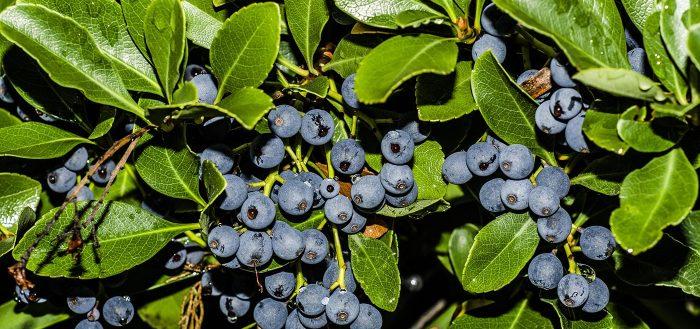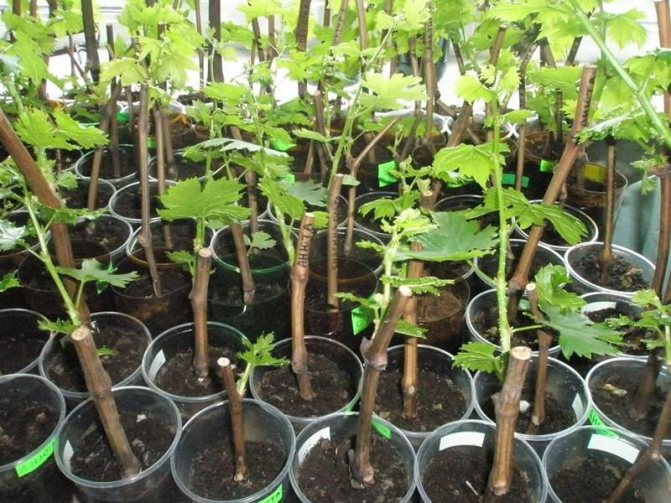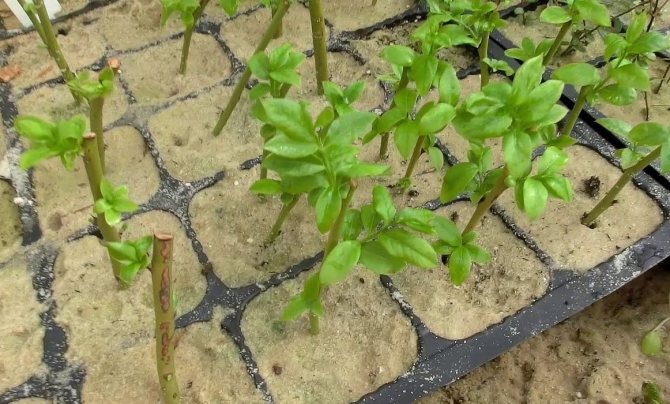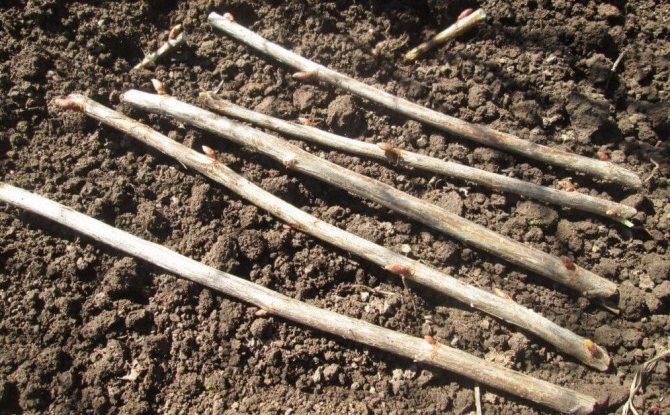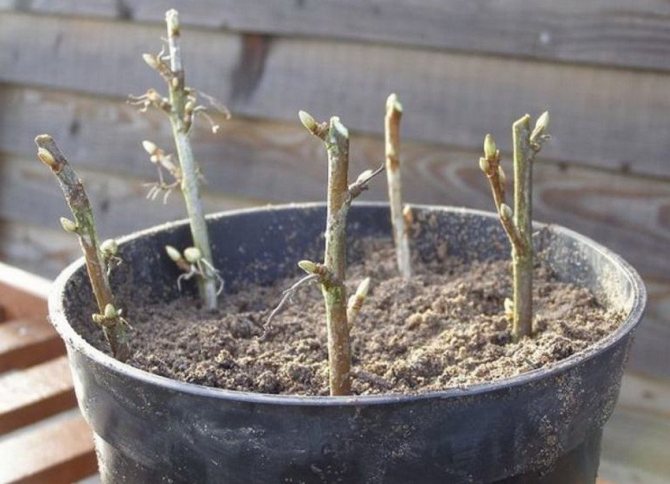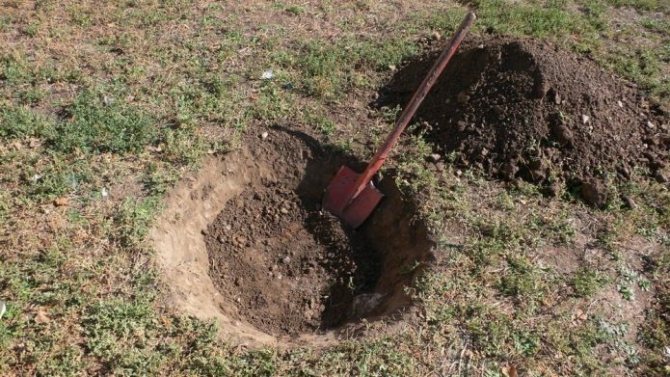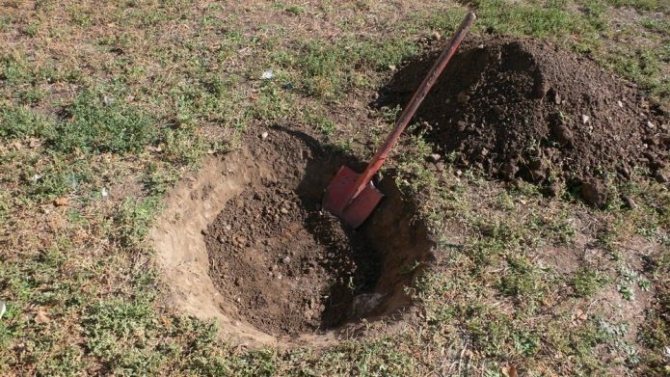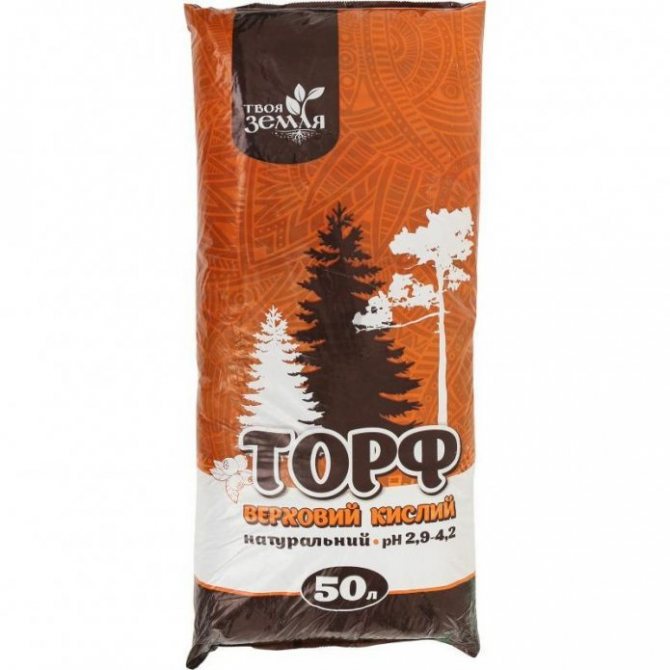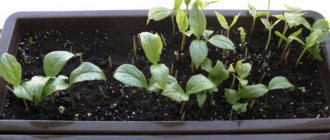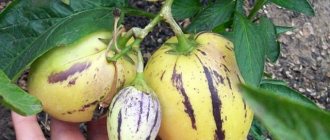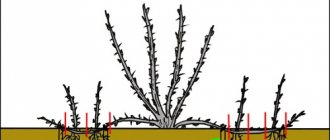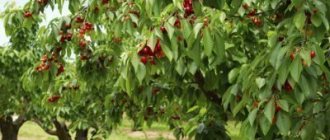Breeding methods for garden blueberries and timing
Blueberry breeding methods are divided into two main groups. It is sexual, which is carried out by seeds and vegetative - by parts of the plant. Seed propagation at home - painstaking work, which includes the rejection of unusable and selection of promising seedlings. This can take several years. Therefore, this method is practiced only for breeding purposes for the development of new varieties.
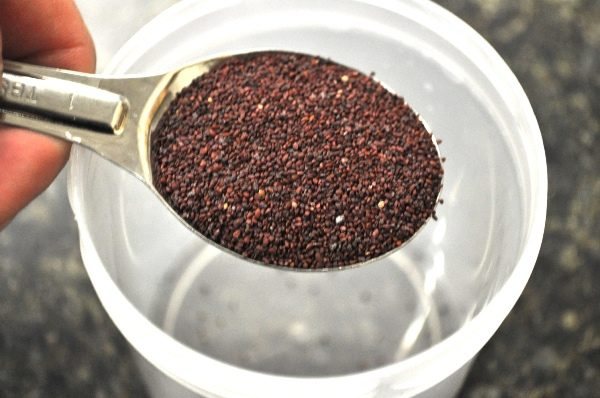
Blueberry seeds
Vegetative (asexual) methods of reproduction allow to preserve the varietal characteristics of blueberries. Each option has its own advantages and disadvantages, so gardeners choose the most suitable method for an individual case.
Reproduction of garden blueberries by cuttings occurs due to the regeneration process, during which new adventitious roots are formed from the tissues of the stem. Shoot growth occurs from the available buds.
When choosing the method of green cuttings, attention is paid to the age of the blueberry shoots. As the shoot becomes lignified, metabolic processes, water content and water-holding capacity of tissues decrease, which are important conditions for the formation of new roots. Thus, planting material from green shoots develops faster, gives a greater percentage of plant survival after rooting.
Seedlings from certain parts of blueberries have varying degrees of rooting. Cuttings from coppice shoots have the highest root-forming ability.... Roots of coppice shoots are formed from adventitious buds, which are characterized by increased metabolism, which accelerates the formation of new cells. This increases root formation by 3-4 times than in cuttings taken from the fruiting zone. Planting material is harvested at the end of June, at the beginning of July.
Blueberries can also be propagated by lignified cuttings... Planting material under optimal conditions can be stored for a certain amount of time. Therefore, lignified cuttings are often harvested for transportation over long distances or for planting for the next season.
There is no specific time to guarantee the best results for cutting cuttings. The opinions of many agronomists are divided on this score. The main condition for the procurement of high-quality planting material is a healthy shoot and dormant buds. In regions with severe winters, it is recommended to harvest cuttings at the beginning of winter, and for other regions it is permissible from December to the first ten days of March.
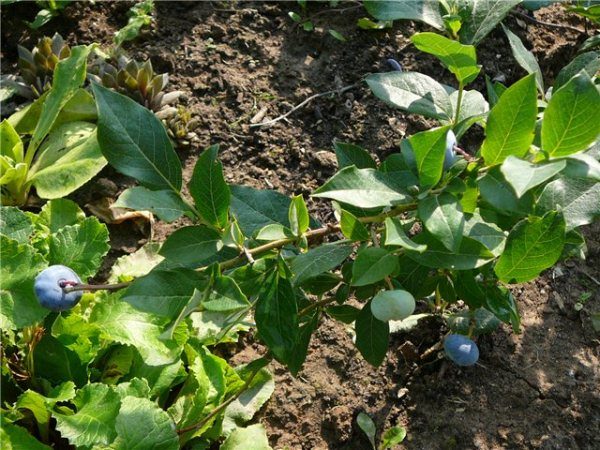

Blueberry seedlings can also be obtained by layering, but this is a long and unproductive process.
Blueberry seedlings can be obtained using cuttings... The essence of this method is to root the stem without separating it from the mother plant. This is one of the natural methods of plant propagation, the technology of which is available to any gardener. The disadvantage of this type of reproduction is the length of the process. Rooting cuttings can last 2-3 years ... The ideal time for this method is during the blueberry growth period, so it is carried out from mid-April to September.
Propagation by cuttings
The methods of harvesting, rooting of green and lignified cuttings have differences and similarities.... Regardless of the planting material, the gardener must carry out the procedure with minimal disruption to the biological characteristics of the plant.
Harvesting green cuttings
With this method of reproduction, compliance with the optimal timing is of particular importance. This is the period from June 20 to July 10 .
Cuttings from insufficiently ripe shoots often suffer from drying out, are affected by diseases and fungal spores. The leaves of such cuttings are underdeveloped and cannot supply the stem with sufficient nutrients. With a later harvesting of cuttings, nutrients enter the growth points, which leads to their loss, affects the formation of roots.
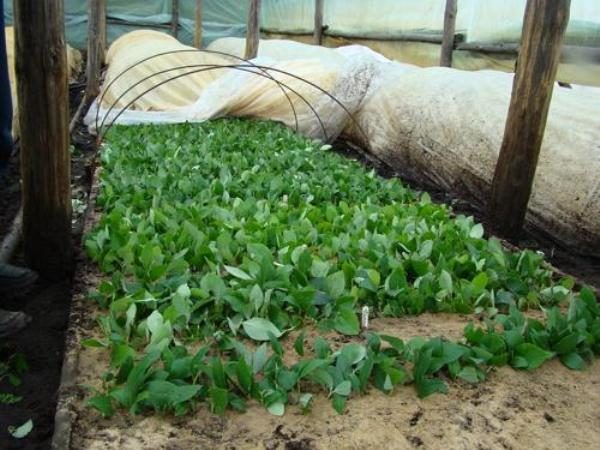

Green blueberry cuttings
Shoots ready for grafting have springy, unbreakable stems and a dark green leaf color. For cutting cuttings, strong shoots of the first and higher orders of branching with a height of 6-12 cm are chosen ... They are broken off by hand with a part of the wood and bark of last year's growth (heel).
Cutting preparation:
- processing of the lower part of the cutting (removal of exfoliated bark);
- removal of 2-3 lower leaves (1/3 of the length);
- trimming the remaining leaves by 1/3;
- treatment of the cuttings with growth stimulants
Cuttings are planted on a prepared ridge in greenhouse conditions.
Harvesting lignified cuttings
For harvesting cuttings, last year's shoots that are completely ripe and not damaged by frost are chosen formation or replacement with a diameter of 0.5-1.2 cm. Cuttings of a larger diameter root poorly, and smaller ones are given by weak plants. Shoots with a large number of flower buds are not suitable for reproduction, and their removal does not give positive results either.
Branches cut in winter are stored in boxes filled with peat or sawdust and openings for aeration. The boxes are placed in a dark, well-ventilated room at an air temperature of 0 ° С- + 5 ° С ... Cuttings are cut at the end of March or in April. The lower parts of the branches are distinguished by the best root-forming ability.


The easiest way to propagate blueberries is lignified cuttings.
Cutting cuttings is done with a sharp pruner, avoiding punching and damage to the bark.
Reproduction by layering
Also, as mentioned above, blueberries can propagate by layering. This method is used for propagation of young bushes that have few shoots for propagation or for varieties that are poorly rooted during propagation.
Before that, the trunk circle under the mother plant is loosened. Pick up strong and healthy shoots. Opposite the selected branches from the base of the bush, a furrow is formed with a depth of 6-8 cm and a length equal to the length of the shoots... Sprinkle with water.
Annual branch growth is shortened by 1/5 and placed in the furrow. Each section of a branch with two developed buds is fixed to the soil using wire hooks. The furrow is sprinkled with sawdust.
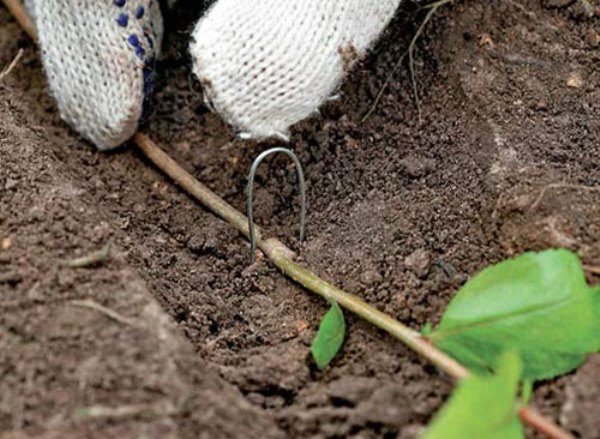

To obtain a full-fledged blueberry seedling, the branch is laid in the furrow and fastened with a crochet
After vertical shoots reach a height of 8-10 cm, they need to be earthed up to half the height... To do this, use a mixture of peat and sawdust (1: 1). This procedure is repeated 2-3 times as the shoots grow back. Throughout the summer, the soil is kept moist and loose. The shoots that have grown in the current year will form a full-fledged root system in 2-3 years, after which they are transplanted to a permanent place.
Blueberries are a relatively new crop in Russian horticulture, the agricultural techniques of which are not fully mastered by gardeners. The secrets of successful cultivation are based on the correct selection of varieties that are highly adaptable to the harsh conditions for this crop.... By planting varieties suitable for the region, it is possible to maintain home blueberry plantations for many years, propagating them vegetatively.
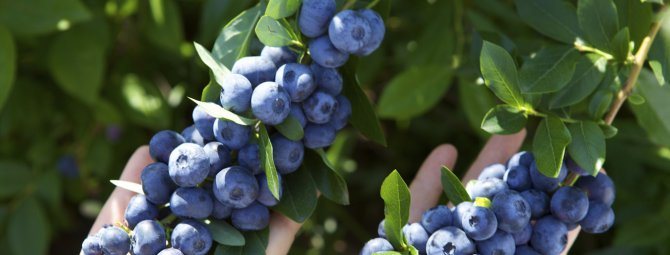

Seedlings are very expensive today, and blueberries are also a rarity in many regions. In addition, purchased bushes take root with great difficulty. Therefore, you have to buy 1–2 roots, and then carefully grow them, propagate them, sometimes even with seeds, in order to get a berry plant that can provide the whole family with vitamins. Plus, growing blueberry seedlings and berries is a great business idea.
What varieties are most suitable for growing at home
I have long wanted to decorate the loggia with fruit plants. It's nice to go to the balcony, sit on a chair, watch the spring bloom and breathe in a pleasant aroma. I thought for a long time and decided to plant blueberries.
Before starting to grow a wild-growing beauty, I studied the species, planting conditions and other factors that affect the development of the plant. From the above table I chose the decorative variety Blyukrop:
| Variety | a brief description of | Region | The soil | Acidity pH |
| Duke | Frost-resistant, self-pollinating, disease-resistant, versatile, early maturing | Central and northern strip of Russia | Loose, sandy-peaty soil | 4,3-4,8 |
| Nelson | Frost-resistant, self-pollinated, the berries are tasty and large | Central and northern strip of Russia | The soil needs acidification, the substrate is rotted sawdust, peat | 3,8-5,0 |
| Bluecrop | Excellent decorative appearance, frost-resistant, drought-resistant and resistant to many diseases | Northern strip of Russia | Peat, black earth, sand | 3,5-5,0 |
| Northland | Decorative, frost-resistant, high-yielding, undersized, demanding on soil acidity, medium early, resistant to pests | Northern and middle strip of Russia | Light and rich substrate, well moistened and drained, high-moor and transitional peat mixtures based on it | 4,5-4,8 |
| Briggita Blue | Late, decorative, tall, self-pollinated, high-yielding | Central and southern strip of Russia | Drained, peat, sawdust, well moistened | 3,5-5,0 |
| Goldtraube 71 | Self-pollinating, frost-resistant, decorative | Extensive | A mixture of pine needles and peat | 4,5-5,5 |
| Rankocas | Late, high-yielding, decorative, frost-resistant | Middle black earth strip of Russia | Drained, well hydrated, light, rich in humus | 4,0-5,0 |
| Elizabeth | Medium late, self-pollinated, frost-resistant, dessert flavor of berries, fruitful, resistant to diseases and pests, large berries | Black earth strip of Russia | Loose soil with moderate peat content | 3,5-4,5 |
| Erliblu | Self-fertile, decorative, frost-resistant | Extensive | Not picky about soil, peat, sawdust, foliage | 3,5-4,5 |
Reproduction of blueberries by cuttings
The best time for cutting cuttings is the last decade of June to early July, inclusive, when the annual increments have not yet become lignified. The event can be combined with thinning the blueberry bush. Cut off the young, thickening twigs.
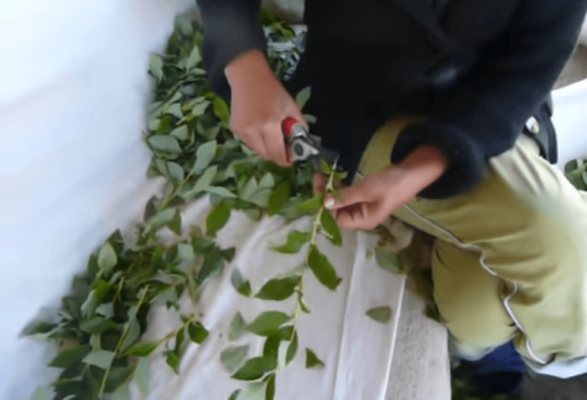

Annual semi-lignified twigs go to the cuttings
Remove more green tops from each shoot. Divide the rest into cuttings with 2-3 internodes. Cut the bottom leaves entirely, leave only the top two and cut them in half. The lower cut of the cutting should be sharp, with a bevel in the opposite direction from the growth of the lower leaf.


And - for grafting, take the middle part of the lateral branch. B - the cut is made at an acute angle and not parallel to the growth of the bottom sheet. B - cuttings are treated with rooting. D - blueberry stalk is planted in a loose and sour substrate
The soil for blueberries should be acidic pH from 4 to 5. This culture is contraindicated: humus, compost, manure and even ordinary garden soil, since they have a slightly acidic and neutral reaction. The substrate can be made up of peat, river sand, coniferous litter and rotted sawdust in any proportion.
Before planting, hold each cutting in a rooting stimulator (Kornevin, Heterooxin, Epin, Ecoel and others).Plant in boxes in rows (5x10 cm) or in separate pots, burying the stalk halfway. Rooting should take place at high humidity and high temperatures. Arrange a mini greenhouse or greenhouse. When young leaves begin to grow on the cuttings, the greenhouse can be ventilated, and after a week, completely removed. In the fall, a month before frost, transplant the grown seedlings to a permanent place.
Video: harvesting cuttings and planting
Planting culture
Every gardener should know how to properly plant blueberries in order to get a good harvest in the future. The shrubs should be planted in rows extending from north to south. This is necessary for the culture to be saturated with sunlight. The row spacing varies depending on the variety:
- undersized bushes - about 60 cm;
- tall - 1-1.5 meters.
If the cultivation of a crop is for industrial purposes, then the aisle is better to make 2 meters so that the special equipment can drive without problems.
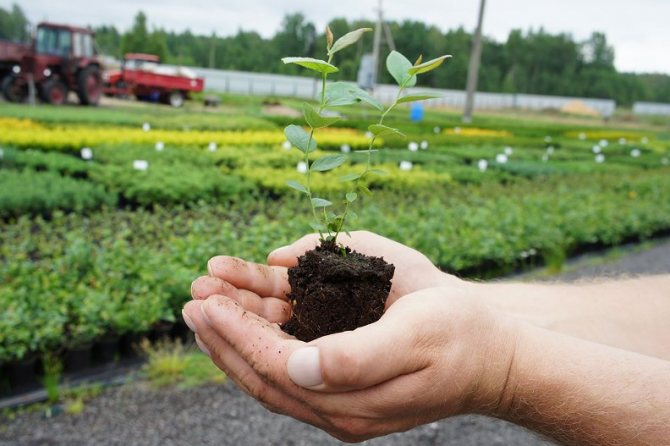

Planting of garden blueberries is carried out in recesses, the size of which is 60x60 cm. The depth of the pit reaches half a meter. The distance between low-growing bushes is 50 cm, between medium-sized bushes - 1 meter, between tall bushes - 120 cm. The bottom of the recess and its walls must be loosened so that air can freely pass to the root system. Before planting, an acidic substrate is laid out in the pit, which is prepared as follows: peat is mixed with needles, sawdust and sand, after which 50 grams of sulfur is introduced into the composition for oxidation. In no case should you add organic matter at this stage, because it alkalizes the soil. Now you can do the landing directly. To do this, the seedling is lowered into a hole, its roots are straightened and it is sprinkled with earth. In this case, the root collar should be underground at a depth of 3 cm from the surface. After planting, young shoots are watered with warm water, and the soil around them is mulched. To do this, mix bark, straw, add coniferous sawdust and straw and cover the plant with this composition from all sides.
Propagation by horizontal layers
In the spring in early summer, choose strong, flexible branches that you can lay on the ground. If it is only possible to bend them in an arc, then the seedling will turn out to be one with roots at the point of contact with the ground, and if you manage to dig in most of the branch, then several bushes will grow. The easiest and most reliable way is to propagate blueberries with horizontal layers:
- Try on a branch where you want to dig it in, and make a shallow (5–7 cm) groove in the ground.
- Scratch the side where the branch will come into contact with the ground at least with a fingernail and moisten with a preparation that enhances root formation.
- Attach the branch to the ground with wire pins and sprinkle with earth. If the branch does not fit, is curved and touches the ground in only one place, you can dig it in and press it down with a brick or stone. In any case, the top of the rooted branch should be outside, above the ground.
- Keep the soil moist throughout the summer.
- Next spring, you can dig up our branch, cut it off from the mother bush and divide it into seedlings. But according to the experience of gardeners, it is known that rooting of blueberry branches has to wait 2-3 years.
Reproduction of blueberry root shoots
Some blueberry varieties, like raspberries, produce root growth. It forms at a distance of at least 30 cm from the main bush. It is better to separate such seedlings in spring, so that they have time to take root well in a new place before autumn. The hardest part is to carefully cut or chop the main root that connects the mother bush and the young growth. Do not under any circumstances pull out the growth. It needs to be dug around, grope for the junction and cut off. Transfer the seedling to a permanent place or place in a container for growing.
Video: separation of a seedling grown from a root cut
When and how to plant?
- Garden blueberries can be planted in autumn and spring.
- Spring planting begins before bud swelling. This enables the plant to undergo an adaptation course.
- Autumn planting is carried out 30 days before persistent frosts (October). Gardeners prefer this time, as the plant has time to take root. When planted in spring, blueberries grow rapidly.
- Closed-root shrubs can be planted throughout vegetative development.
- Several bushes and preferably different varieties should be planted. This will improve pollination.
- If the plants have a closed root system, then the whole lump should be sent into the water and kept until the bubbles go. As soon as they stopped, it means that the root is saturated with water.
- Then, knead the wet ball and straighten the roots for better survival.
- Sometimes the lump is very dense - it's not scary. In this case, you need to cut it. It will be enough to cut to a depth of 7 cm.
- Within a month, the bush is covered with agrofibre or coniferous branches from the scorching sun.
- To retain moisture, the plant is mulched with sawdust.
- The direction of the seedling should be north-south.
Blueberry seed
Seed propagation is a very interesting, but also time consuming way:
- Seeds can be bought in a store in your city, ordered over the Internet, collected by yourself from berries, either your own or bought on the market.
- The soil is sour peat, it can be mixed with coarse sand and rotted sawdust. Peat tablets are great.
- Sowing dates are easy to calculate. Stratification for blueberries lasts up to 90 days, it is advisable to get seedlings in March, when the sun begins to illuminate our windowsills well. Therefore, it is necessary to start working with blueberry seeds already at the beginning of December.
- Sowing is carried out superficially without deepening. Blueberry seeds are very small, the seedlings will not have enough strength to break through even through loose soil. Moisten the substrate before sowing, if you water it after, the water will pull the seeds deep into the soil. You can sow in rows in the seedling box or individually each seed in a peat tablet or glass.
- Cover crops with glass or wrap in a plastic bag and place on the bottom shelf of the refrigerator for 3 months. Once a week, you need to take out, ventilate and moisturize if necessary.
- In March, transfer crops to a light and warm windowsill. Seedlings should appear in 1-3 weeks. Grow them like normal seedlings. But do not forget to take a special acidic soil from peat for picking without adding earth, humus and other components familiar to us.


Blueberry seeds and loose substrate
Video: stratification rules in the refrigerator and in the garden under the snow
Further care
- A prerequisite for blueberries is soil.
- The plant grows well in acidic and light soil.
- To increase acidity, sulfuric acid, ammonium sulfate and food acid (citric, acetic, malic) are used. If electrolyte is available for cars, then it can also be used.
The main thing is not to overdose. The optimal variant of the acidity level is pH 4.4-3.2. To do this, add components in small portions and measure the composition of the soil with a pH meter or litmus paper.
- Watering is done once every 14 days. The dosage for an adult plant is 10 liters.
- Check the acidity of the soil once every 2 weeks. For this, a surface layer of 7 cm is removed and a handful of earth is collected for verification. If the acidity level is insufficient, add, for example, electrolyte diluted with water (1: 1).
- Apply complex fertilizers.
- Free the seedlings from weeds.
- Spray from caterpillars.
- For prophylaxis in the spring and autumn, spray the seedlings with a Bordeaux mixture.
- Prune young plants.
- Carry out weeding of the surface layer by no more than 5 cm. So the root system is very close to the top layer of the earth.
Blueberries are an undemanding plant and are easy to care for.The following are the main points of crop care.
Watering
Blueberries are harmed by the drying out of the soil, so the plant will have to be watered often. It is better to use a watering can for watering. It will not dissolve the mulch, which must be near the trunk of the plant. The optimum soil moisture content is 60–70%. To maintain such humidity, the bush should be watered abundantly 2 times a week in the evening. In July-August, the number of waterings can be increased up to 3 times. This will improve the yield and help the formation of flower buds for the next year.
Despite the fact that blueberries are a moisture-loving plant, they do not tolerate stagnant water, so be sure to drain the hole during planting.
During periods of drought and heat, shrubs can be sprayed with water in the evening. This will help the plant avoid the stress it can get during high temperatures.
Top dressing


Blueberries react poorly to organic fertilizers such as green manure, manure and compost. The only thing that suits her is sour high peat or half-ripe coniferous litter. It is better to use mineral fertilizers to feed the crop. It is necessary to start feeding the bushes 3 years after planting.
Mineral fertilizers for blueberries:
- Nitrogen. Stimulates shoot growth and fruit formation. In a year, it is enough to add 60 g under a bush.
- Phosphorus. Influences yield and disease resistance. A year for one bush, 50 g is enough.
- Potassium. Helps the plant to resist diseases. With fertilization, the bushes are easier to tolerate winter and drought. It is enough for one bush to get 40 g of the substance per year.
Blueberry fertilization plan:
- In early spring, when the plant is just beginning to wake up, it is necessary to apply nitrogen fertilizers under the bush.
- During budding, blueberries can be sprayed with a growth stimulant.
- During the formation of berries, the bushes can be fed with complex fertilizers.
- In August, it will be useful for the plant to receive fertilization with potassium-phosphorus fertilizers.
Mulching
Mulching is a must when caring for blueberry bushes. You can carry out the procedure using:
- sawdust;
- straw;
- coniferous bark;
- leaves;
- needles.
Despite the fact that buds bloom later with a layer of mulch in spring, this is only better for the plant. Thus, early frosts will not harm the future harvest.
The optimal mulch layer should be up to 15 cm. The procedure will help not only maintain moisture in the soil, but also prevent the growth of weeds. Mulching also protects the root system of the plant from low temperatures in winter.
Important! As a result of mulching with fresh sawdust, the plant increases its nitrogen intake from the soil, so in the spring, when mulching, additionally feed the blueberries with nitrogen fertilizers.
Pruning
It is necessary to start pruning and forming a bush from the third year after planting. Weak, damaged and diseased shoots are systematically removed. It is better to prune in the spring before bud break. If the procedure is carried out in the fall, then the cut site may suffer from severe frosts in winter.
Consider the following during your annual pruning period:
- Young bushes need to be cut harder. This procedure stimulates the growth of the plant.
- Only erect growths should be preserved, and low spreading ones should be cut off. At least 5 annual shoots should remain on the shrub.
- Fruiting bushes over 5 years old should be dominated by shoots over 4 years old.
- With a very dense crown, you can cut out internal old and weak branches.
- Remove small and thin branches. Leave only strong shoots and skeletal branches.
- After pruning, do not leave cut branches near the bush. Better to burn them on the same day. This way, you will prevent the development of infections on them.
To a large extent, pruning depends on the blueberry variety:
- in bushes with wide crowns, the entire top of the plant is cut off;
- in bushes with a more elongated shape, it is necessary to prune the strongest shoots to stimulate their growth;
- in bushes with a dense and dense crown, the most branched shoots are shortened;
- the most productive blueberry varieties with a large number of branches need to thin out the bush well every year.
Did you know? Blueberries have more antioxidants than any vegetable or fruit.
Breeding blueberries does not always give the desired result. The plant survival rate is low. But if you adhere to all the tips given in the article, the culture will be healthy and strong, and numerous berries can delight you for a long time in the garden and on the table.
Blueberry micropropagation
Seedlings from test tubes are already appearing in our stores. In addition, an army of gardeners is replenishing who know what meristems are and how plants develop from them. Micropropagation is the growing of a seedling from a piece of tissue (meristem) of the mother plant. The apical meristems are mainly used. Their cells are actively dividing and lead to a continuous growth of leaves, stems, flowers.


Plants are obtained by microclonal method - from a piece of tissue
For an ordinary landowner, if it is possible to grow blueberries from cuttings or shoots, this method looks very illogical, complicated and costly. You will need laboratory equipment and a nutrient solution, and it is for this culture. And it is also necessary to ensure optimal temperature conditions and sufficient illumination. After growing in a test tube, the plants are accustomed to normal non-sterile conditions.
However, this technology makes it possible to obtain thousands of seedlings from one branch, moreover, absolutely healthy and repeating all the properties of the mother plant. The method of artificial propagation is actively spreading around the world, it is interesting to breeders and companies selling planting material.
Video: the advantages of micropropagation and its main stages
Blueberries are considered a promising berry for business. In many countries, it is grown commercially. For example, in Belarus, the planting area is 500 hectares, more than 100 farms are engaged in breeding. Belarusian gardeners can buy both imported tall varieties and unique local ones, for example, with white fruits.
Video: blueberry cultivation in Belarus
Blueberry cultivation is a promising business. By purchasing 2-3 seedlings of different varieties, you can eventually grow a whole berry plantation, which is in high demand in the market. The most popular propagation methods are cuttings and layering, and large enterprises are adopting the microclonal method.
Many gardeners are interested in how to properly propagate blueberries. Today, there are many ways to carry out this manipulation. You can get a new plant by cuttings. Also, the culture is propagated by seeds, layering, root shoots. Each method has certain advantages and disadvantages. In order for the manipulation to give the desired results, it is necessary to strictly follow the recommendations for its implementation.
On a note
Dear friends, the first experience in growing blueberries was successful. Now she has bred four varieties of Duke, Nelson, Northland and the beautiful Elizabeth. Believe me, this is great! Caring for green pets is a real pleasure. My harvest in a season reaches 20 kg, I do not buy frozen blueberries in the supermarket. She grows on a loggia!
Try to grow one bush, this activity is fun. Fruit plants are living organisms, reciprocate love, give delicious berries.
Blueberry breeding methods and optimal timing
There are quite a few ways to breed garden blueberries. Each of them has certain pros and cons.
Cuttings
Blueberries reproduce well by cuttings. They are usually harvested in the summer. In the fall, the planting material should be prepared for storage, and in the spring, transplanted into the ground.
Green cuttings
This is the most commonly used blueberry breeding method. It is recommended to start harvesting green cuttings at the end of June. To do this, it is worth choosing high-quality shoots that do not have defects. Gardeners advise cutting branches that have at least 5 buds.
After cutting the material, it is worth preparing the ground. To do this, it is recommended to mix sand with peat in a ratio of 1: 3. Cuttings should be planted in the prepared mass. It is important to follow the 5x5 centimeters scheme. Cutting is recommended to be carried out in a container. It is covered with foil.
After a couple of months, the cuttings take root. In winter, it is recommended to cover blueberries with peat and sawdust. In the spring, the cuttings are planted in a greenhouse and watered.


